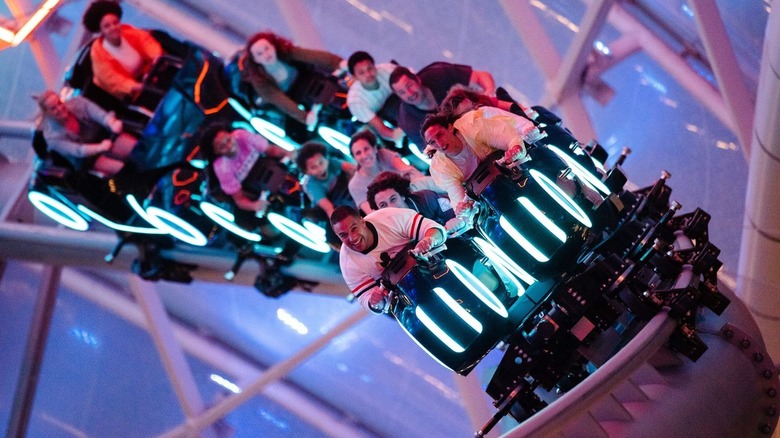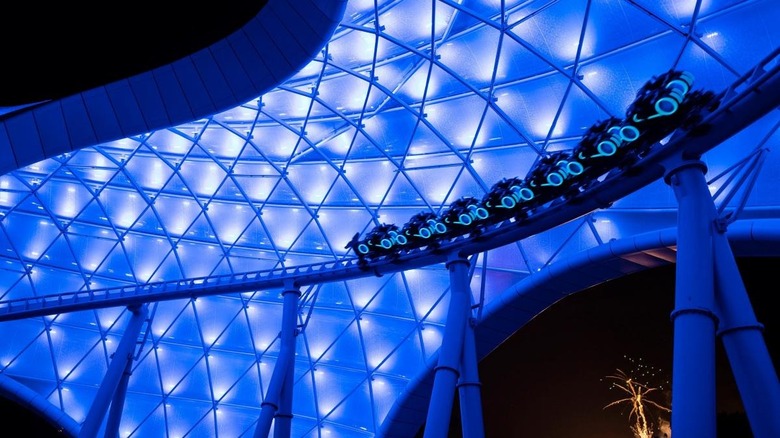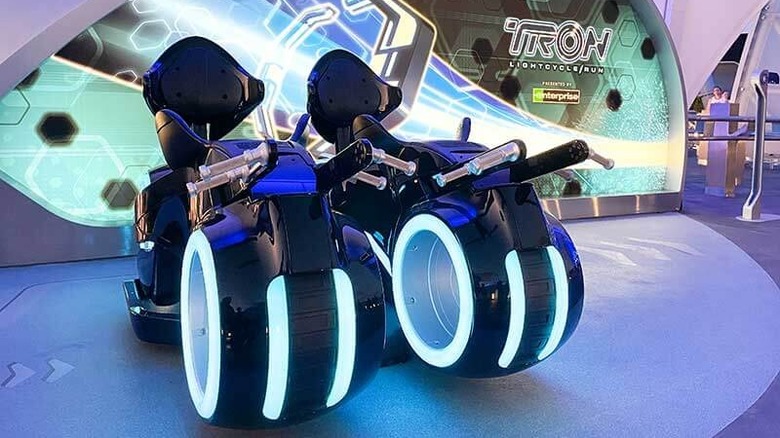The Biggest Problem At Disney And Universal Theme Parks Is Keeping People Off The Best Rides
Although there's no rule saying that you have to ride a theme park attraction once you get in line for it, it's rare to see people walk out of the line once they've arrived at the loading area. Most of the time, if that does happen, it's likely because a parent has failed to convince their young child to experience an attraction that seems tailor-made to shake them to their core. But just as theme parks like Walt Disney World and Universal Studios have tried one-upping each other by making more technologically complex attractions themed to everything from the Harry Potter films to "Avatar," they've also established a new reason why people can't ride some of the best rides: Their seats are for those under a certain weight.
Though the need for people to literally test out rides before they enter a line is not a new one, it's an issue at both Orlando-based resorts. At the Magic Kingdom in Walt Disney World, for example, one of the biggest new rides is Tron Lightcycle / Run. (Yes, the slash is officially part of the title.) The concept of the ride is that you've been sucked into the world of Tron for a race on the slick lightcycle vehicles to see if you can clear eight gates on your team faster than other "programs" can. But the ride vehicle itself is both restrictive and oddly uncomfortable. I speak from recent experience, having spent the first week of the month at the Walt Disney World resort for the first time in over a decade. (Side note, but in case you were wondering, it is immensely odd to be at the Magic Kingdom the day after a U.S. presidential election.) So in many ways, it was like visiting Disney for the first time, especially in the brave new world of Tron.
Considering that the ride experience itself lasts upwards of 90 seconds (and that's if you're being generous about the start of the attraction), you have to go through a lot of hoops to ride Tron Lightcycle / Run. After dropping off any fairly large loose items at free indoor lockers (such as your wallet or purse), you go to the loading area, where Disney Cast Members politely but firmly and repeatedly encourage you to put any smaller loose items in the small compartment directly below your face on your given lightcycle, because otherwise you're liable to lose it. This is all to say that while I was able to ride Tron Lightcycle / Run, I don't know that I felt like I saw it in full, because I had to take off my glasses while on the ride. (Since the initial boost of speed sends you soaring pretty fast in a brief outdoor section, I'm liable to believe that I could've lost my specs on the ride.)
The unspoken rule of theme park rides
Walt Disney World had, prior to the arrival of the lightcycles, largely avoided the kind of fat-shaming controversies that Universal has experienced with a number of its newer attractions, such as Harry Potter and the Forbidden Journey, Hagrid's Motorbike Adventure, and ... well, if it's in the Wizarding World of Harry Potter, chances are there's a test vehicle for you to check out in front of the queue to see if you can fit to begin with. But it makes sense that people who are too big to ride compare the feeling of having to exit an attraction after waiting in line with a walk of shame or "climbing the gallows." On one hand, yes, it's an extreme case of hyperbole. On the other hand, while waiting to experience Tron, my son and I watched a woman and her child have to exit not because the child was too small for the ride based on its minimum height requirements, but because she was too big for the already-constricting vehicle. Unlike even the Harry Potter attractions, Tron's vehicle setup means you literally have to kneel before the lightcycle constraints push upon your back and shove you forward. (I only learned from more experienced visitors online that the back row of each set of Tron vehicles allows you to sit normally.)
The notion of essentially "fat testing" new attractions may seem ridiculous, but it's becoming all too common and necessary. (There's even a theme park vlogger whose handle is literally "Fat Tested Travel.") That's because theme park designers are attempting to top themselves with each new E-ticket they come up with. Doing so makes sense; just as Walt Disney's oft-trotted-out quote that "Disneyland is not a museum" is interpreted accurately as a sign that the parks should never stay stagnant for too long, it means that the newest attraction may just be a bar for the competition to clear. But in the same way that the theme parks can't be overly stodgy, they can't all lean so heavily on thrill rides that they end up alienating people who don't meet the unspoken weight requirement.
The unspoken aspect of that requirement is a critical aspect, too. When a child complains that they're too small to ride Guardians of the Galaxy: Cosmic Rewind, it can be deflating for that child, but the Epcot Cast Members check height for obvious safety reasons. (On that attraction, especially, as it takes place almost entirely in dark spaces, so parents wouldn't even be able to see if their kids are tall enough for certain big drops of the ride.) And moreover, Disney and Universal announce height requirements in person, on their mobile apps, on their websites, and other places. You can try to ignore those rules, but they're unavoidable. But some guests may not notice the area outside an attraction queue where they can briefly sit down to ensure a (relatively) comfortable fit. It's extremely easy to bypass these areas, especially since the attractions that have so-called "Fat testing" areas are all but certainly the most popular. If Disney Cast Members or Universal Team Members have to give their lungs a workout to ensure people know which line to enter based on their ticket type, you almost have to have dedicated employees stopping everyone at the front to make sure they're not the "wrong" size to experience something.
Walt Disney World is supposed to have something for everyone
One reason why a trip to Walt Disney World can be so joyous is that there is something, ostensibly, for everyone. If you enjoy live entertainment, there are daily musical performances, parades, and fireworks. If you like slow-moving attractions, you can experience everything from Pirates of the Caribbean to Living with the Land to a handful of dark-ride-style attractions meant to remind you about the beauty and wonder of a handful of Disney's animated classics. And if you like thrill rides, you can enjoy Big Thunder Mountain, the Seven Dwarfs Mine Train, and plenty of others. But these latter attractions — as much as they may break technological or creative boundaries by blending screen and live sets, making ride vehicles do 360-degree spins when you least expect them, and/or sending you through a whirlwind of entertainment, energy, and effects — have unnecessarily imposed limitations.
At Disney, the best-case scenario, as opposed to what goes on in Tomorrowland with Tron, is in their Animal Kingdom theme park. There, the newest and most oft-visited land is themed to "Avatar," boasting both a low-key boat ride with a purportedly dazzling Audio-Animatronic character (who tends to have technical difficulties, as was the case during my most recent trip) and a hyper-stylized ride called Flight of Passage, in which riders (44 inches or taller) can experience what it's like to ride one of the Banshees from the James Cameron films. Like the Tron attraction, the ride apparatus isn't standard, but closer to a motorcycle-style experience. And yet, even with the addition of 3D glasses, sitting down to go through a close-up IMAX-style view of Pandora while a vehicle mimics the movement of a Banshee was one of the most thrilling and least restrictive experiences at the entire resort. Where Tron with its lightcycles offers just an initial thrill, as the vehicle sails outside briefly (an effect that's doubly cool at night), Flight of Passage goes out of its way to make you feel like the lead character in the original "Avatar," hampered by his own body but freed in the world of the Na'Vi. That the Disney and Universal theme parks can push such boundaries only makes it all the more vexing when their own rides force people to lose a crucially enjoyable experience.


